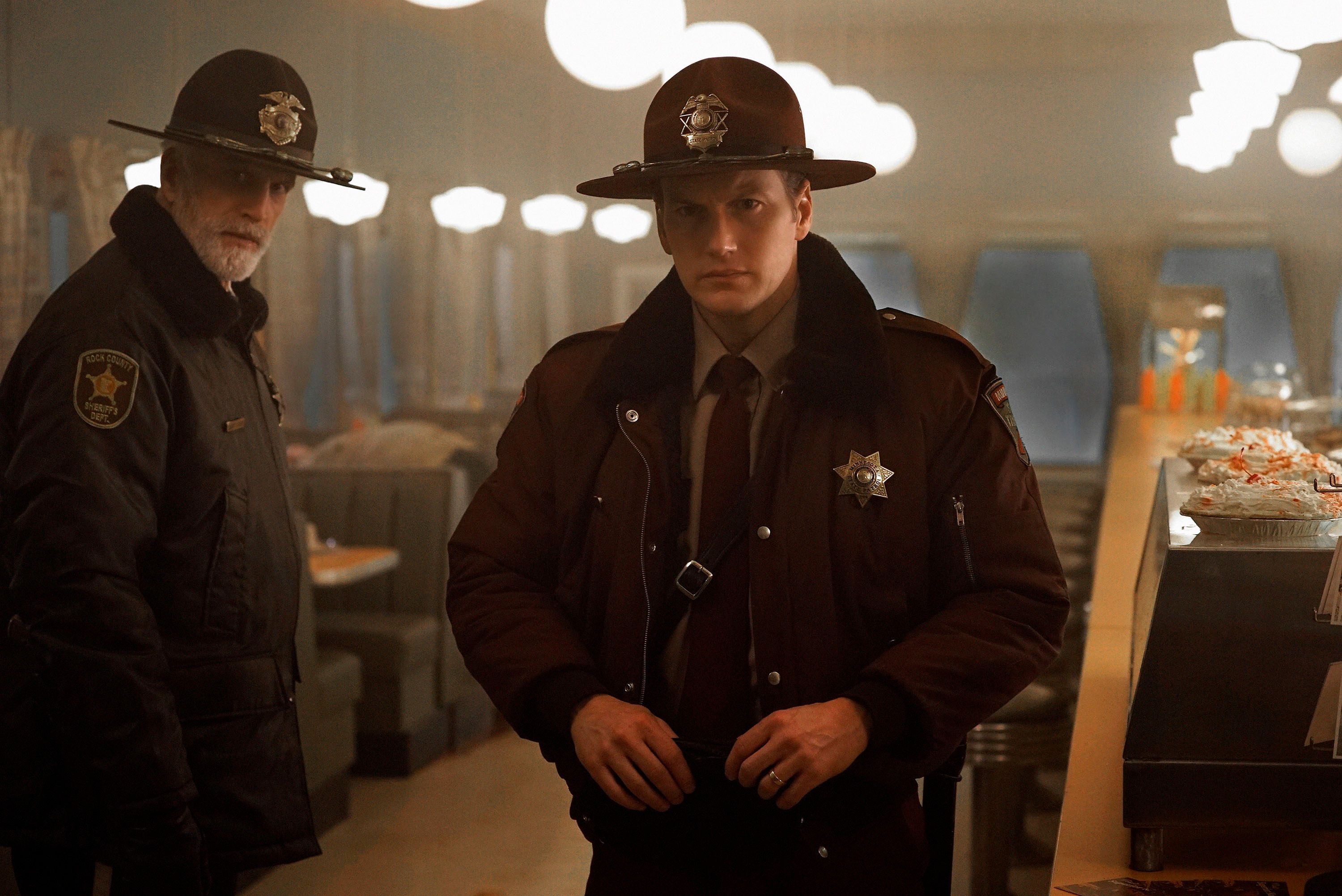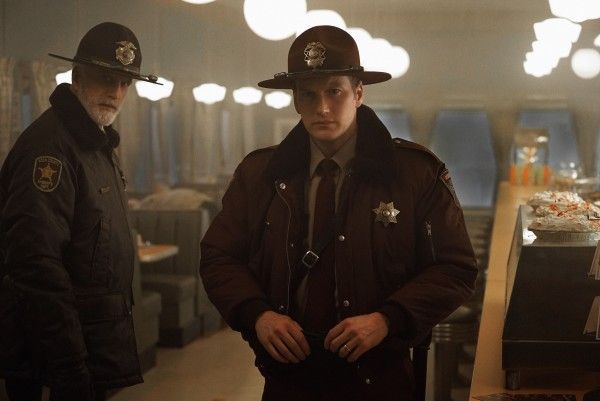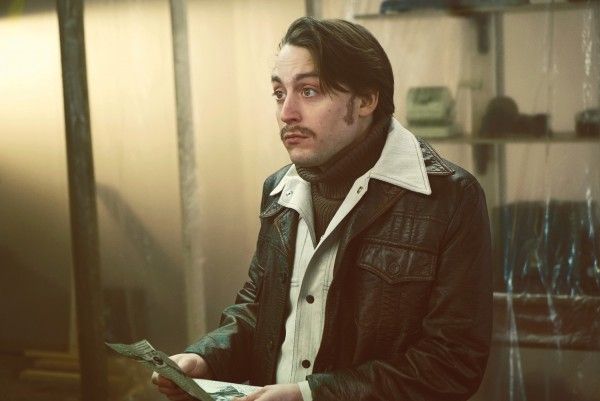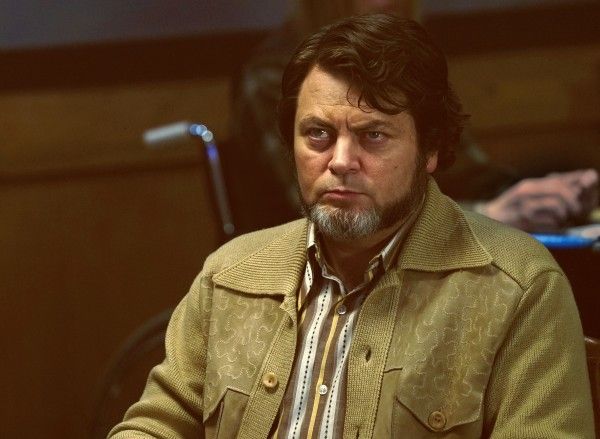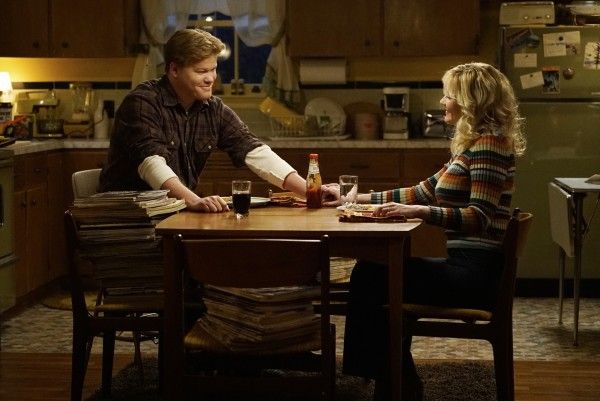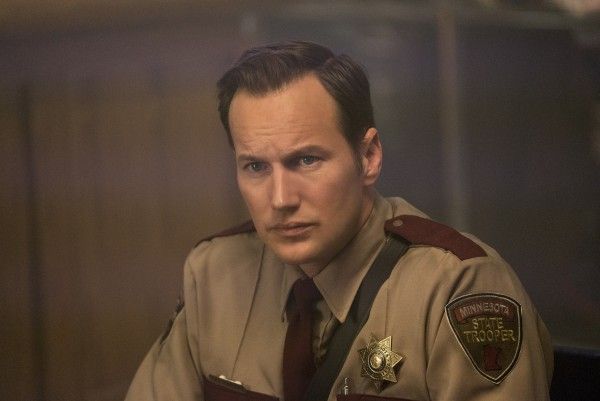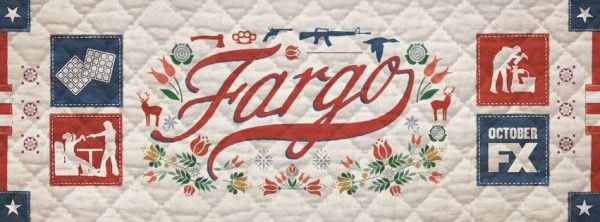Admit it, when you first heard FX was adapting Fargo, one of Joel and Ethan Coen's most beloved films, into a TV series, you probably thought it was a terrible idea. I know I did. And yet, somehow, against the odds, series creator Noah Hawley managed to produce a show that honored the original film while establishing a narrative and style all it's own.
After an Emmy, Golden Globe and Peabody winning debut, Fargo returns for it’s highly-anticipated second season tonight on FX. Using an anthological approach to the storytellingoffers enormous freedom, allowing it to dip into the vast and varied filmography of the Coens, cross time periods, and introduce a huge cast of new characters. Season 2 jumps back in time to 1979, following the young Lou Solverson — the character originated by Keith Carradine -- as he confronts the grizzly Sioux Falls massacre alluded to in Season 1.
On a brisk, breezy location shoot in Calgary, Canada I spoke with Hawley and the cast about the wild, interwoven narrative of Fargo’s second season. Hawley didn’t initially intend to connect the two seasons, a decision that was ultimately borne out of his interest in Lou's character and the promise of a throwaway line. Hawley explained, “You start off thinking it’s a completely different story, then you realize there is a connection. The connection is not central to the plot of the whole story, but it’s an interesting connection.” Hawley continued, “I started out with the Sioux Falls reference in episode 2 as just a way to give Molly’s dad something so that he could see that he was going through something that he had seen himself.Then the more I thought about it, I thought that’s really interesting and the idea of Sioux Falls and what might have happened there really started to intrigue me, so I started to lay in some more references and by the end of the season I had a pretty fleshed out idea of what we were going to do.”
Patrick Wilson takes over the role of young Lou, and while he wanted to honor the performance turned in by Carradine, he wasn’t interested in mimicking. “I’ve done roles where I’ve sat there and looked at every speech pattern and every ism and tick and this really wasn’t that,” said Wilson. “Lou’s not a real person, so it’s ok to make your own stamp. I love Keith, and Keith has this soulful almost folksy kind of appeal, and I want to carry that weight, but I also know a lot of that comes with age and with the experience that you’re having. I know me at 20 years ago was a totally different feel.”
While on set, we watched them film a re-shoot of a key sequence in the premiere episode. The local diner, The Waffle House, is littered with bodies, the pie-lined counters speckled with blood in the aftermath of a confrontation gone wrong. This is where we find Lou. A dedicated state trooper embroiled in the gruesome case that would haunt him into his later years.
Season 2 also introduces Lou’s wife, Betsy, played by Cristin Milioti in an against-type turn. “She’s so intelligent and so strong and so stoic. Very curious. I think that still waters run deep with her. There’s a lot going on, but she doesn’t show it necessarily.” Cancer, raising Molly.
Then there’s Betsy’s father, Hank Larsson, world war II vet and fellow officer of the law who bonds with Lou over war stories. Ted Danson, rocking an epic silver-white beard, described Hank as a deep thinker who talks in a whimsical, slightly over flowery cowboy poet kind of way.” Like Lou, he’s a solid good guy, the American archetype of a hero, no-nonsense with a strong moral compass and backbone to match. “At the end of the day, he’ll stand up on a porch and face down 10 guys with guns knowing he doesn’t stand a chance,” said Danson.
Hank and Lou’s investigation into the Waffle House murders sets the directly at odds with the Gerhardts, the ruling family of the local crime syndicate led by Jean Smart’s matriarchal Flloyd and her power-hungry son Dodd (Jeffrey Donovan). As the mother and son battle it out for the top spot, the powerful Kansas City mafia angles to acquire their territory.
Caught in the middle of all the madness is Peggy Blumquist (Kirsten Dunst), a small-town beautician with a hunger for more. When a small twist of fate, and an even small act of conscience, pulls Peggy into the fray, she drags in her husband Ed (Jesse Plemmons), a simple man and devoted husband. Together the two are a portrait of Minnesota nice gone twisted “Peggy’s a little delusional,” said Dunst, “She thinks they’re going to get away with all this stuff. She thinks it’s all going to work out.”
Hawley sets the action in 1979 Luverne, Minnesota, and the sets and costumes are all stylized reflections of the era. Peggy and Ed’s home is a monochromatic ode to burnt orange, shag rug and all. Lou’s sports skin tight magenta pants as his state trooper uniform. Betsy’s bob is so shellacked, it’s practically a helmet.
The time period also offers up a bounty of thematic possibilities. Hawley explained his approach to the setting, “We’re in this tumultuous post-watergate, post-Vetnam, the Black Panther movement and Wounded Knee; it was really a country in revolution on some levels. Hawley continued “[I] not only use that as a backdrop for a story, but to think on a thematic and character level. Who are those characters that represent that story? That second wave feminism. You can have it all. All those cultural struggles that were going on.”
While the post-Vietnam aspect manifests itself fairly traditionally through the character of Lou Solverson, some of the other themes reveal themselves in unexpected ways. Hawley uses the Gerhardt syndicate to explore the rise of the corporation and the death of the family business. Executive Producer Warren Littlefield explained,. “In that era, [there was] the larger thematic of the corporatization of America. We’re not so much about family businesses anymore, they can’t survive. What’s the most dramatic way of looking at [that]? A crime family business and a war that’s declared on them by the Kansas City Mob.”
Since it’s Fargo, even the most serious subject matter is handled with the pitch-black humor and distinct tone that originates in the films of the Coens. As Dunst put it, it’s all very “Coen-esque”. She continued, “I’ve heard Noah call it 'No Country for Old Fargo', so there’s definitely that Western element “ One of the most impressive feats of Fargo’s first season was the way that Hawley was able to craft an original story while integrating that idiosyncratic, off-beat tone. And the series is set to repeat that success with Season 2. Donovan explained, “It is 100% Coen brother tone as imagined and tried to be dead spot on as the Coen brothers. That’s what he went for in Season 1 and he’s doing the exact same thing in Season 2. The themes are different, but the tone is exactly the same.”
Donovan recalled a lot of laughter on set, even during the dark, disturbing scenes, “There’s a scene between me and a couple other characters and it’s a pretty brutal, bad scene — what’s happening — but everybody was laughing in the tent, and that’s Coen brothers. In the midst of really violent action, there’s humor. There it was again. It didn't happen because we were acting like Coen brother characters, Noah created a situation, hired hopefully good actors and the writing lent itself to a moment that kind of just happened.”
Dunst recalled similar experiences filming her scenes, “It’s a dark comedy Especially Peg and Ed’s stuff, I learn it very seriously and then Jesse and I will be in rehearsal and we’ll just start laughing, because it’s so funny. You forget, because you take yourself seriously in the role and the role is serious, what she’s doing is serious to her, but the way it’s written is so hilarious sometimes.”
Even with such an expansive narrative before them, the series still manages to squeeze in a few direct Coen homages according to Wilson. “There are definite references — there’s a Miller’s Crossing reference, there’s a Lebowski in there.”
Of course that tone means a lot of grisly dark humor and moments that revel in the horror of humanity. Milioti described it as, “When you’re laughing at something and you know you shouldn’t be, and then the next moment you’re horrified.” Littlefield similarly commented, “We’re still Fargo…we don’t leave the tonal Fargo world, but we’re different. We’re informed by our period, we’re informed a little bit by some different Coen films, and our canvas is so much larger.”
Indeed, Fargo's second season promises to be bigger and better with more characters, a rich period to pull from and an expansive tapestry of a narrative. Since speaking to Hawley and the cast on set, I’ve had the opportunity to view the first four episodes of Fargo’s sophomore season. Does it live up to that promises? Oh, yah. You betcha.

